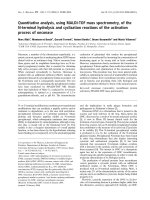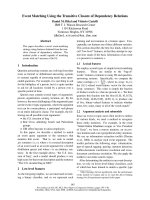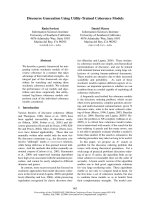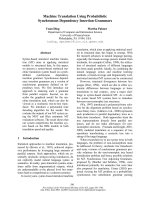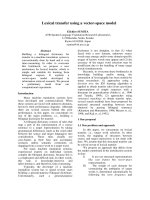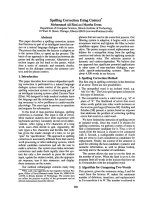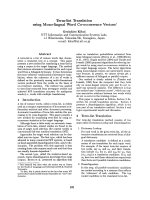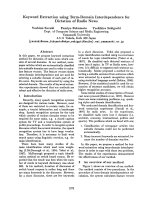Báo cáo khoa học: "Term Recognition Using Technical Dictionary Hierarchy" docx
Bạn đang xem bản rút gọn của tài liệu. Xem và tải ngay bản đầy đủ của tài liệu tại đây (70.9 KB, 8 trang )
Term Recognition Using Technical Dictionary Hierarchy
Jong-Hoon Oh, KyungSoon Lee, and Key-Sun Choi
Computer Science Dept., Advanced Information TechnologyResearch Center (AITrc), and
Korea Terminology Research Center for Language and Knowledge Engineering (KORTERM)
Korea Advanced Institute of Science & Technology (KAIST)
Kusong-Dong, Yusong-Gu Taejon, 305-701 Republic of Korea
{rovellia,kslee,kschoi}@world.kaist.ac.kr
Abstract
In recent years, statistical approaches on
ATR (Automatic Term Recognition) have
achieved good results. However, there are
scopes to improve the performance in
extracting terms still further. For example,
domain dictionaries can improve the
performance in ATR. This paper focuses on
a method for extracting terms using a
dictionary hierarchy. Our method produces
relatively good results for this task.
Introduction
In recent years, statistical approaches on ATR
(Automatic Term Recognition) (Bourigault,
1992; Dagan et al, 1994; Justeson and Katz,
1995; Frantzi, 1999) have achieved good results.
However, there are scopes to improve the
performance in extracting terms still further. For
example, the additional technical dictionaries
can be used for improving the accuracy in
extracting terms. Although, the hardship on
constructing an electronic dictionary was major
obstacles for using an electronic technical
dictionary in term recognition, the increasing
development of tools for building electronic
lexical resources makes a new chance to use
them in the field of terminology. From these
endeavour, a number of electronic technical
dictionaries (domain dictionaries) have been
acquired.
Since newly produced terms are usually made
out of existing terms, dictionaries can be used as
a source of them. For example, ‘distributed
database’ is composed of ‘distributed’ and
‘database’ that are terms in a computer science
domain. Further, concepts and terms of a domain
are frequently imported from related domains.
For example, the term ‘Geographical
Information System (GIS)’ is used not only in a
computer science domain, but also in an
electronic domain. To use these properties, it is
necessary to build relationships between
domains. The hierarchical clustering method
used in the information retrieval offers a good
means for this purpose. A dictionary hierarchy
can be constructed by the hierarchical clustering
method. The hierarchy helps to estimate the
relationships between domains. Moreover the
estimated relationships between domains can be
used for weighting terms in the corpus. For
example, a domain of electronics may have a
deep relationship to that of computer science. As
a result, terms in the dictionary of electronics
domain have a higher probability to be terms of
computer science domain than terms in the
dictionary of others do (Felber, 1984).
The recent works on ATR identify the
candidate terms using shallow syntactic
information and score the terms using statistical
measure such as frequency. The candidate terms
are ranked by the score and are truncated by the
thresholds. However, the statistical method
solely may not give accurate performance in
case of small sized corpora or very specialized
domains, where the terms may not appear
repeatedly in the corpora.
In our approach, a dictionary hierarchy is
used to avoid these limitations. In the next
section, we describe the overall method
description. In section 2, section 3, and section 4,
we describe primary methods and its details. In
section 5, we describe experiments and results
1 Method Description
The description of the proposed method is
shown in figure 1. There are three main steps in
our method. In the first stage, candidate terms
that are complex nominal are extracted by a
linguistic filter and a dictionary hierarchy is
constructed. In the second stage, candidate terms
are scored by each weighting scheme. In
dictionary weighing scheme, candidate terms are
scored based on the kind of domain dictionary
where terms appear. In statistical weighting
scheme, terms are scored by their frequency in
the given corpus. In transliterated word
weighting scheme, terms are scored by the
number of transliterated foreign words in the
terms. In the third stage, each weight is
normalized and combined to Term weight
(W
term
), and terms are extracted by Term weight.
Figure 1. The method description
2 Dictionary Hierarchy
2.1 Resource
Field
Agrochemical, Aerology, Physics, Biology,
Mathematics, Nutrition, Casting, Welding,
Dentistry, Medical, Electronical engineering,
Computer science, Electronics, Chemical
engineering, Chemistry and so on.
Table 1. The fragment of a list: dictionaries of
domains used for constructing the hierarchy.
A dictionary hierarchy is constructed using
bi-lingual dictionaries (English to Korean) of the
fifty-seven domains. Table 1 lists the domains
that are used for constructing the dictionary
hierarchy. The dictionaries belong to domains of
science and technology. Moreover, terms that do
not appear in any dictionary (henceforth we call
them unregistered terms) are complemented by a
domain tagged corpus. We use a corpus, called
ETRI-KEMONG test collection, with the
documents of seventy-six domains to
complement unregistered terms and to eliminate
common term.
2.2 Constructing Dictionary Hierarchy
The clustering method is used for constructing
a dictionary hierarchy. The clustering is a
statistical technique to generate a category
structure using the similarity between
documents (Anderberg, 1973). Among the
clustering methods, a reciprocal nearest
neighbor (RNN) algorithm (Murtaugh, 1983)
based on a hierarchical clustering model is used,
since it joins the cluster minimizing the increase
in the total within-group error sum of squares at
each stage and tends to make a symmetric
hierarchy (Lorr, 1983). The algorithm to form a
cluster can be described as follows:
1. Determine all inter-object (or
inter-dictionary) dissimilarity.
2. Form cluster from two closest objects
(dictionaries) or clusters.
3. Recalculate dissimilarities between new
cluster created in the step2 and other
object (dictionary) or cluster already
made. (all other inter-point dissimilarities
are unchanged).
4. Return to Step2, until all objects
(including cluster) are in the one cluster.
In the algorithm, all objects are treated as a
vector such as D
i
= (x
i1
, x
i2
, , x
iL
). In the step
1, inter-object dissimilarity is calculated based
on the Euclidian distance. In the step2, the
closest object is determined by a RNN. For
given object i and object j, we can define that
there is a RNN relationship between i and j
when the closest object of i is object j and the
closest object of j is object i. This is the reason
why the algorithm is called a RNN algorithm. A
dictionary hierarchy is constructed by the
algorithm, as shown in figure 2. There are ten
domains in the hierarchy – this is a fragment of
whole hierarchy.
Technical
Dictionaries
Domain
tagged
Documents
….A CB D ….
Constructing
hierarchy
POS-tagged
Corpus
Linguistic filter
Abbreviation and
Translation pairs
extraction
Candidate term
Frequency based
Weighing
Transliterated
Word detection
Transliterated word
Based Weighting
Complement
Unregistered Term
Scoring by hierarchy
Eliminate
Common Word
Dictionary based
Weighting
Statistical
Weight
Transliterated
Word Weight
Dictionary
Weight
Term Recognition
Figure 2. The fragment of whole dictionary
hierarchy : The hierarchy shows that domains
clustered in the terminal node such as chemical
engineering and chemistry are highly related.
2.3 Scoring Terms Using Dictionary
Hierarchy
The main idea for scoring terms using the
hierarchy is based on the premise that terms in
the dictionaries of the target domain and terms
in the dictionary of the domain related to the
target domain act as a positive indicator for
recognizing terms. Terms in the dictionaries of
the domains that are not related to the target
domain act as a negative indicator for
recognizing terms. We apply the premise for
scoring terms using the hierarchy. There are
three steps to calculate the score.
1. Calculating the similarity between the
domains using the formula (2.1) (Maynard
and Ananiadou, 1998)
where
Depth
i
: the depth of the domain
i
node in the
hierarchy
Common
ij
: the depth of the deepest node
sharing between the domain
i
and the
domain
j
in the path from the root.
In the formula (2.1), the depth of the node
is defined as a distance from the root – the
depth of a root is 1. For example, let the
parent node of C1 and C8 be the root of
hierarchy in figure 2. The similarity between
“Chemistry” and “Chemical engineering” is
calculated as shown below in table 2:
Domain Chemistry Chemical
Engineering
Path from
the root
Root->C8->
C9->
Chemistry
Root->C8->C9->
Chemical
Engineering
Depth
i
4 4
Common
ij
3 3
Similarity
ij
2*3/(4+4) =0.75 2*3/(4+4) =0.75
Table 2. Similarity
ij
calculation: The table shows
an example in caculating similarity using formula
(2.1). In the example, Chemical engineering
domain and Chemistry domain are used. Path,
Depth, and Common are calculated according to
figure 1. Then similarity between domains are
determined to 0.75.
2.Term scoring by distance between a target
domain and domains where terms appear:
where
N: the number of dictionaries where a
term appear
Similarity
ti
: the similarity between the
target domain and the domain dictionary
where a term appears
For example, in figure 2, let the target
domain be physics and a term ‘radioactive’
appear in physics, chemistry and astronomy
domain dictionaries. Then similarity between
physics and the domains where the term
‘radioactive’ appears can be estimated by
formula (2.1) as shown below. Finally,
Score(radioactive) is calculated by formula
(2.2) – score is (0.4+1+0.7)/3.:
N 3
similarity
physics-chemistry
0.4
similarity
physics-physics
1
similarity
physics-astronomy
0.7
Score(radioactive) 2.1*1/3 = 0.7
Table 3. Scoring terms based on similarity
between domains
3. Complementing unregistered terms and
common terms by domain tagged corpora.
)1.2(
2
ji
ij
ij
depthdepth
Common
similarity
+
×
=
)2.2(
1
)(
1
∑
=
=
N
i
ti
similarity
N
termScore
where
W: the number of words in the term ‘
α
‘
dof
i
: the number of domain that words in
the term appear in the domain tagged
corpus.
Consider two exceptional possible cases. First,
there are unregistered terms that are not
contained in any dictionaries. Second, some
commonly used terms can be used to describe a
special concept in a specific domain dictionary.
Since an unregistered term may be a newly
created term of domains, it should be considered
as a candidate term. In contrast with an
unregistered term, common terms should be
eliminated from candidate terms. Therefore, the
score calculated in the step 2 should be
complemented for these purposes. In our method,
the domain tagged corpus (ETRI 1997) is used.
Each word in the candidate terms – they are
composed of more than one word – can appear
in the domain tagged corpus. We can count the
number of domains where the word appears. If
the number is large, we can determine that the
word have a tendency to be a common word. If
the number is small, we can determine that the
word have a high probability to be a valid term.
In this paper, the score calculated by the
dictionary hierarchy is called Dictionary Weight
(W
Dic
).
3. Statistical Method
The statistical method is divided into two
elements. The first element, the Statistical
Weight, is based on the frequencies of terms.
The second element, the Transliterated word
Weight, which is based on the number of
transliterated foreign word in the candidate term.
This section describes the above two elements.
3.1. Statistical Weight: Frequency Based
Weight
In the Statistical Weight, not only
abbreviation pairs and translation pairs in a
parenthetical expression but also frequencies of
terms are considered. Abbreviation pairs and
translation pairs are detected using the following
simple heuristics:
For a given parenthetical expression A(B),
1. Check on a fact that A and B are
abbreviation pairs. The capital letter of A is
compared with that of B. If the half of the
capital letter are matched for each other
sequentially, A and B are determined to
abbreviation pairs (Hisamitsu et. al, 1998).
For example, ‘ISO’ and ‘International
Standardization Organization’ is detected as
an abbreviation in a parenthetical expression
‘ISO (International Standardization
Organization)’.
2. Check on a fact that A and B are translation
pairs. Using the bi-lingual dictionary, it is
determined.
After detecting abbreviation pairs and
translation pairs, the Statistical Weight (W
Stat
) of
the terms is calculated by the formula (3.1).
where
α
:
a candidate term
|
α
|
: the length of a term’
α
’
S (
α
): abbreviation and translation pairs of
‘
α
’
T(
α
): The set of candidate terms that nest
‘
α
’
f(
α
): the frequency of ‘
α
’
C(T(
α
)): The number of elements in T(
α
)
In the formula (3.1), the nested relation is
defined as follows: let A and B be a candidate
term. If A contains B, we define that A nests B.
The formula implies that abbreviation pairs
and translation pairs related to ‘α’ is counted as
well as ‘α’ itself and productivity of words in
the nested expression containing ‘α’ gives more
weight, when the generated expression contains
‘α’. Moreover, formula (1) deals with a single-
word term, since an abbreviation such as GUI
(Graphical User Interface) is single word term
and English multi-word term usually translated
to Korean single-word term – (e.g. distributed
database => bunsan deitabeisu)
)3.2(*)1)(()(
1
W
dof
ScoreW
W
i
i
Dic
∑
=
+=
αα
(
)
+×
×
=
∑
∑
∑
∪∈
∈
∪∈
}{)(
)(
}{)(
)1.3(
))((
)(
)(
)(
)(
ββα
αγ
ββα
α
γ
αα
ααα
β
S
T
S
Stat
otherwise
TC
f
f
nestedisiff
W
3.2 Transliterated word Weight: By
Automatic Extraction of Transliterated
words
Technical terms and concepts are created in
the world that must be translated or transliterated.
Transliterated terms are one of important clues
to identify the terms in the given domain. We
observe dictionaries of computer science and
chemistry domains to investigate the
transliterated foreign words. In the result of
observation, about 53% of whole entries in a
dictionary of a computer science domain are
transliterated foreign words and about 48% of
whole entries in a dictionary of a chemistry
domain are transliterated foreign words. Because
there are many possible transliterated forms and
they are usually unregistered terms, it is difficult
to detect them automatically.
In our method, we use HMM (Hidden Markov
Model) for this task (Oh, et al., 1999). The main
idea for extracting a foreign word is that the
composition of foreign words would be different
from that of pure Korean words, since the
phonetic system for the Korean language is
different from that of the foreign language.
Especially, several English consonants that
occur frequently in English words, such as
‘p’, ’t’, ’c’, and ‘f’, are transliterated into Korean
consonants ‘p’, ‘t’, ‘k’, and ‘p’ respectively.
Since these consonants of Korean are not used in
pure Korean words frequently, this property can
be used as an important clue for extracting a
foreign word from Korean. For example, in a
word, ‘si-seu-tem’ (system),
the syllable ‘tem’
have a high probability to be a syllable of
transliterated foreign word, since the consonant
of ‘t’ in the syllable ‘tem’ is usually not used in
a pure Korean word. Therefore, the consonant
information which is acquired from a corpus can
be used to determine whether a syllable in the
given term is likely to be the part of a foreign
word or not.
Using HMM, a syllable is tagged with ‘K’ or
‘F’. A syllable tagged with ‘K’ means that it is
part of a pure Korean word. A syllable tagged
with ‘F’ means that it is part of a transliterated
word. For example, ‘si-seu-tem-eun (system is)’
is tagged with ‘si/F + seu/F + tem/F + eun/K’.
We use consonant information to detect a
transliterated word like lexical information in
part-of-speech-tagging. The formula (3.2) is
used for extracting a transliterated word and the
formula (3.3) is used for calculating the
Transliterated Word Weight (W
Trl
). The formula
(3.3) implies that terms have more transliterated
foreign words than common words do.
where
s
i
: i-th consonant in the given word.
t
i
: i-th tag (‘F’ or ‘K’) of the syllable in the
given word.
where
|
α
| is the number of words in the term
α
trans(
α
) is the number of transliterated
words in the term
α
4.Term Weighting
The three individual weights described above
are combined according to the following
formula (4.1) called Term Weight (W
Term
) for
identifying the relevant terms.
Where
ϕ
: a candidate term ‘
ϕ
’
f,g,h : normalization function
α
+
β
+
γ
= 1
In the formula (4.1), the three individual
weights are normalized by the function f, g, and
h respectively and weighted parameter
α
αα
α
,
β
ββ
β
, and
γ
γγ
γ
. The parameter
α
αα
α
,
β
ββ
β
, and
γ
γγ
γ
are determined by
experiment with the condition
α
αα
α
+
β
ββ
β
+
γ
γγ
γ
= 1. Each
value which is used in this paper is
α
αα
α
=0.6,
β
ββ
β
=0.1, and
γ
γγ
γ
=0.3 respectively.
)3.3(
)(
)(
α
α
α
trans
W
Trl
=
)2.3()|(),|(
)|()()()|(
13
21
121
=
∏∏
==
−−
n
i
ii
n
i
iii
tsptttp
ttptpSPSTP
)1.4())(())((
))(()(
ϕγϕβ
ϕαϕ
StatTrl
Dicterm
WhWg
WfW
×+×
+×=
5. Experiment
The proposed method is tested on a corpus of
computer science domains, called the KT test
collection. The collection contains 4,434
documents and 67,253 words and contains
documents about the abstract of the paper (Park.
et al., 1996). It was tagged with a part-of-speech
tagger for evaluation. We examined the
performance of the Dictionary Weight (W
Dic
) to
show its usefulness. Moreover, we examined
both the performance of the C-value that is
based on the statistical method (Frantzi. et al.,
1999) and the performance of the proposed
method.
5.1 Evaluation Criteria
Two domain experts manually carry out the
assessment of the list of terms extracted by the
proposed method. The results are accepted as the
valid term when both of the two experts agree on
them. This prevents the evaluation from being
carried out subjectively, when one expert
assesses the results. The results are evaluated by
a precision rate. A precision rate means that the
proportion of correct answers to the extracted
results by the system.
5.2 Evaluation by Dictionary Weight
(W
Dic
)
In this section, the evaluation is performed
using only W
Dic
to show the usefulness of a
dictionary hierarchy to recognize the relevant
terms The Dictionary Weight is based on the
premise that the information of the target
domain is a good indicator for identifying terms.
The term in the dictionaries of the target domain
and the domain related to the target domain acts
as a positive indicator for recognizing terms.
The term in the dictionaries of the domains,
which are not related to the target domain acts as
a negative indicator for recognizing terms. The
dictionary hierarchy is constructed to estimate
the similarity between one domain and another.
Top 10% Bottom 10%
The Valid Term 94% 54.8%
Non-Term 6% 45.2%
Table 4. terms and non-terms by Dictionary
Weight
The result, depicted in table 4, can be
interpreted as follows: In the top 10% of the
extracted terms, 94% of them are the valid terms
and 6% of them are non-terms. In the bottom
10% of the extracted terms, 54.8% of them are
the valid terms and 45.2% of them are non-terms.
This means that the relevant terms are much
more than non-terms in the top 10% of the result,
while non-terms are much more than the
relevant terms in the bottom 10% of the result.
The results are summarized as follow:
!"According as a term has a high
Dictionary Weight (W
Dic
), it is apt
to be valid.
!"More valid terms have a high
Dictionary Weight (W
Dic
) than
non-terms do
5.3 Overall Performance
Table 5 and figure 3 show the performance of
the proposed method and of the C-value method.
By dividing the ranked lists into 10 equal
sections, the results are compared. Each section
contains the 1291 terms and is evaluated
independently.
C-value The proposed
method
Section
# of
term
Precision # of
term
Precision
1 1181 91.48% 1241 96.13%
2 1159 89.78% 1237 95.82%
3 1207 93.49% 1213 93.96%
4 1192 92.33% 1174 90.94%
5 1206 93.42% 1154 89.39%
6 981 75.99% 1114 86.29%
7 934 72.35% 1044 80.87%
8 895 69.33% 896 69.40%
9 896 69.40% 780 60.42%
10 578 44.77% 379 29.36%
Table 5. Precision rates of C-value and the
proposed method : Section contain 1291 terms and
precision is evaluated independently. For example,
in section 1, since there are 1291 candidate terms
and 1241 relevant terms by the proposed method,
the precision rate in section 1 is 96.13% .
The result can be interpreted as follows. In the
top sections, the proposed method shows the
higher precision rate than the C-value does. The
distribution of valid terms is also better for the
proposed method, since there is a downward
tendency from section 1 to section 10. This
implies that the terms with higher weight scored
by our method have a higher probability to be
valid terms. Moreover, the precision rate of our
method shows the rapid decrease from section 6
to section 10. This indicates that most of valid
terms are located in the top sections.
20%
30%
40%
50%
60%
70%
80%
90%
100%
12345678910
Section
Precision
The Proposed method C-value
Figure 2. The performance of C-value and the
proposed method in each section
The results can be summarized as follow
:
!"The proposed method extracts a valid
term more accurate than C-value does.
!"Most of the valid terms are in the top
section extracted by the proposed
method.
Conclusion
In this paper, we have described a method for
term extraction using a dictionary hierarchy. It is
constructed by clustering method and is used for
estimating the relationships between domains.
Evaluation shows improvement over the C-value.
Especially, our approach can distinguish the
valid terms efficiently – there are more valid
terms in the top sections and less valid terms in
the bottom sections. Although the method
targets Korean, it can be applicable to English
by slight change on the Tweight (W
Trl
).
However, there are many scopes for further
extensions of this research. The problems of
non-nominal terms (Klavans and Kan, 1998),
term variation (Jacquemin et al., 1997), and
relevant contexts (Maynard and Ananiadou,
1998), can be considered for improving the
performance. Moreover, it is necessary to apply
our method to practical NLP systems, such as an
information retrieval system and a
morphological analyser.
Acknowledgements
KORTERM is sponsored by the Ministry of Culture
and Tourism under the program of King Sejong
Project. Many fundamental researches are supported
by the fund of Ministry of Science and Technology
under a project of plan STEP2000. And this work
was partially supported by the KOSEF through the
“Multilingual Information Retrieval” project at the
AITrc.
References
Anderberg, M.R. (1973) Cluster Analysis for
Applications. New York: Academic
Bourigault, D. (1992) Surface grammatical analysis
for the extraction of terminological noun phrases.
In Proceedings of the 14
th
International Conference
on Computational Linguistics, COLING’92 pp.
977-981.
Dagan, I. and K. Church. (1994) Termight:
Identifying and terminology In Proceedings of the
4th Conference on Applied Natural Language
Processing, Stuttgart/Germany, 1994. Association
for Computational Linguistics.
ETRI (1997) Etri-Kemong set
Felber Helmut (1984) Terminology Manual,
International Information Centre for Terminology
(Infoterm)
Frantzi, K.T. and S.Ananiadou (1999) The
C-value/NC-value domain independent method for
multi-word term extraction. Journal of Natural
Language Processing, 6(3) pp. 145-180
Hisamitsu, Toru and Yoshiki Niwa (1998) Extraction
of useful terms from parenthetical expressions by
using simple rules and statistical measures. In First
Workshop on Computational Terminology
Computerm’98, pp 36-42
Jacquemin, C., Judith L.K. and Evelyne, T. (1997)
Expansion of Muti-word Terms for indexing and
Retrieval Using Morphology and Syntax, 35
th
Annual Meeting of the Association for
Computational Linguistics, pp 24-30
Justeson, J.S. and S.M. Katz (1995) Technical
terminology : some linguistic properties and an
algorithm for identification in text. Natural
Language Engineering, 1(1) pp. 9-27
Klavans, J. and Kan M.Y (1998) Role of Verbs in
Document Analysis, In Proceedings of the 17
th
International Conference on Computational
Linguistics, COLING’98 pp. 680-686.
Lauriston, A. (1996) Automatic Term Recognition :
performance of Linguistic and Statistical
Techniques. Ph.D. thesis, University of Manchester
Institute of Science and Technology.
Lorr, M. (1983) Cluster Analysis and Its Application,
Advances in Information System Science,8 ,
pp.169-192
Murtagh, F. (1983) A Survey of Recent Advances in
Hierarchical Clustering Algorithms, Computer
Journal, 26, 354-359
Maynard, D. and Ananiadou, S. (1998) Acquiring
Context Information for Term Disambiguation In
First Workshop on Computational Terminology
Computerm’98, pp 86-90
Oh, J.H. and K.S. Choi (1999) Automatic extraction
of a transliterated foreign word using hidden
markov model , In Proceedings of the 11th Korean
and Processing of Korean Conference pp. 137-141
(In Korean).
Park, Y.C., K.S. Choi, J.K.Kim and Y.H. Kim (1996).
Development of the KT test collection for
researchers in information retrieval. In the 23th
KISS Spring Conference (in Korean)
